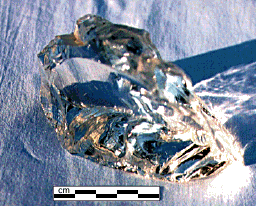




Optical glass is used for optical
instruments, such as binoculars, spectacles, lenses, prisms,
telescopes, and microscopes. It must be absolutely flawless, completely transparent and able to be ground into shape. Of all glass types, it has the widest range of compositions, each having slightly different ingredients and optical properties.

During the Second World War, the Optical Munitions Panel recommended that six types of optical glass should be made in Australia:
The production of optical glass requires special ingredients, in particular a high grade, iron-free source of silica (sand). Aeolian sand is considered one of the best types of sand for making optical glass and, fortunately, Australia had a domestic source of this essential ingredient at Botany, in Sydney.
Other ingredients required for optical glass came from various Australian states:
The remaining ingredients were supplied by the UK (potassium nitrate and hydrated alumina) and the USA (borax and boric acid) and had been stockpiled by Australian Consolidated Industries before war broke out.
(1)
However, while Australia had all the ingredients to make optical glass, we did not have the procedures in place to do so. Optical glass is hard to form and expensive to produce; extraordinarily high temperatures are required to melt the quartz sands and these temperature make the mixture highly reactive. This can lead to contamination of the mixture through chemical reactions with containers that hold the molten glass. Optical glass is also a very viscous product, and it is difficult to get tiny bubbles out of the mixture.
To make optical glass, fine sand and various mixtures of oxides, such as potash (potassium oxide), soda (sodium oxide), lime (calcium oxide) and magnesium oxide are melted together in a pot. The pot, or refractory, is lined with, or made of, special clays. As mentioned above, the glass produced in the refractory can be affected by impurities in the clay which leak out of the clay and into the 'melt' of optical glass.
Australian Consolidated Industries, in conjuction with Professor Hartung from the University of Melbourne, tested over 100 clays from all over Australia until they found the right clays to use in their pot construction.
In June 1941, Hartung reported:
Following the production of the 'melt', the optical glass is then poured into moulds which form prisms, lens blanks and slabs. Prism cubes of up to 5 inches (12.7 cm) and lenses of up to 8 inches (20.3 cm) were made by an Australian Consolidated Industries subsidiary: Australian Window Glass Pty Ltd, in Sydney.
After moulding, the glass blanks are annealed. Annealing is the process of controlled thermal treatment to lower the level of strain inside the
glass caused by uneven cooling. It involves raising the glass to a high enough temperature to relieve the strain, then the glass is gradually cooled again. Optical glass needs the most careful annealing because of the significant effect of residual strain on the final optical properties of the glass.
Much work has been done on the testing and selection of
suitable pot clays for melting optical glass. After the accumulation of
sufficient evidence from our experiments in Melbourne, I went to Sydney
towards the end of February last, and discussed the whole matter fully
with the staff of Messrs. A.C.I. who are concerned with the development
of the project. As a result, a standard blend of four pot clays was
selected for use in the making of full scale pots for the production of
optical glass.(2)
(1)
D.P. Mellor (1958), 'Optical Munitions', Australia in the War of 1939-1945: The Role of Science and Industry, ch. 12, series 4: civil, vol. 5, Australian War Memorial, Canberra, p. 255.
(2)
J.S. Rogers, The History of the Optical Munitions Panel: July 1940 - December 1946, Australian Archives, Brighton, Melbourne, MP 730/11, Box 3, p. 49.








Published by the Australian
Science Archives Project on
ASAPWeb, 30 April 1997
Comments or corrections to:
Bright Sparcs (bsparcs@asap.unimelb.edu.au)
Prepared by: Denise Sutherland
and Elissa Tenkate
Updated by: Elissa Tenkate
Date modified: 19 February 1998
 | Top | Bright Sparcs |
ASAPWeb |
| Top | Bright Sparcs |
ASAPWeb |
